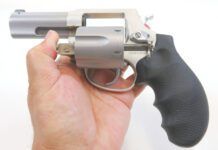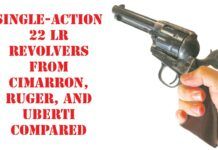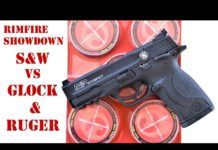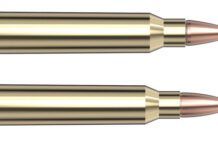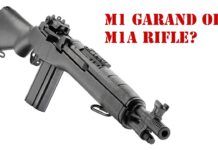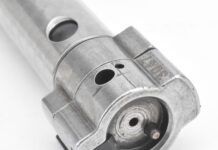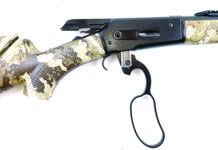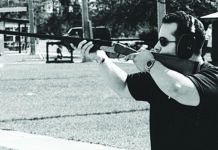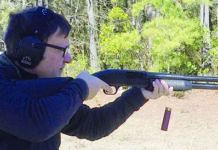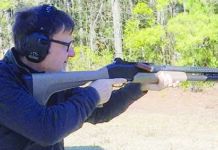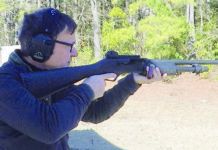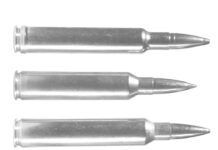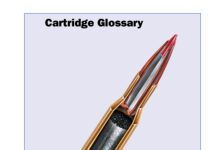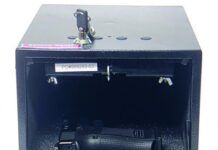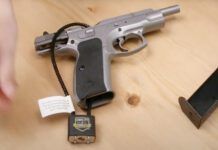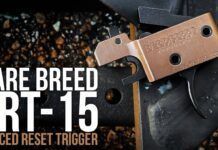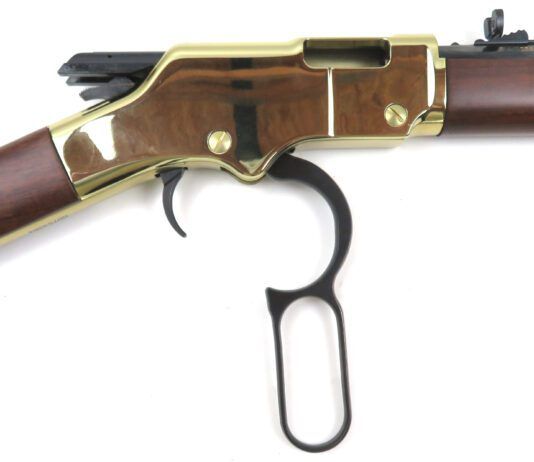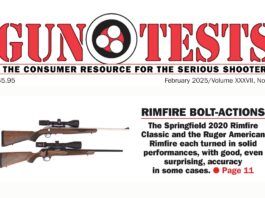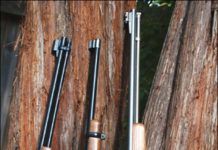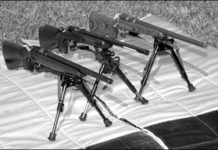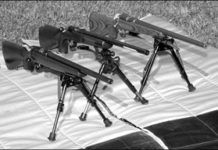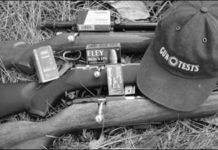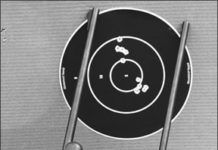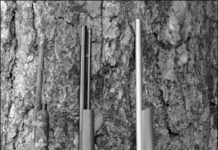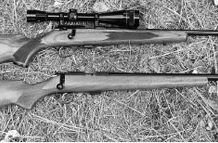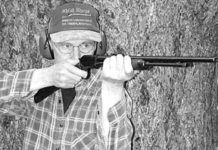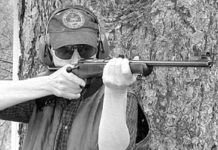22 Magnums: Marlins 983S Bolt Gun Is a Magnum Bargain
The high demand and short supply of ammunition in recent months has left many rifle shooters scrambling for alternatives to their centerfire firearms. While rimfire rounds may not be the complete answer to the problem—some types of rimfire ammunition in also in short supply—the popularity of the less expensive bullets is growing.
Those shooters interested in a little more punch for the dollar are turning to 22 Magnum offerings. With more knock-down capability than a Long Rifle round and selling for at about half the cost of common centerfire ammunition, the magnums seem to be a good choice.
We selected the 22 Magnums because they can satisfy the plinking desires of firearm enthusiasts without breaking the bank; and they offer varmint-stopping punch for shooters interested in bagging small game. We selected three different actions of 22 Magnum rifles for our test, including one model that was recently discontinued and has become something of a sought-after collector's item. Each of the rifles has a dedicated fan base, with some favoring the old-style lever action; some siding with the normally more accurate bolt action; and some interested in the rapid-fire power of a semiautomatic.
The three rifles in our test were the lever-action Henry Model H001M, $420; the bolt-action Marlin Model 983S, $320; and the discontinued (2006) semiauto Ruger Model 10-22, which is selling for about $600 on several gun-trading websites. Despite the continuing drain on ammunition supplies because of volume purchases, there are still many different varieties of affordable 22 Magnum ammo available at most sporting-goods outlets.
We selected three types of ammunition for our test of the three rifles to check out the effectiveness and grouping of different loads. Our test ammunition included CCI Maxi Mag TNT 30-grain hollowpoints with an average muzzle velocity of 2,200 fps; Remington Premier Magnum Rimfire 33-grain Accutip-V rounds with an average muzzle velocity of 2,000 fps, and Winchester Supreme High Velocity 30-grain jacketed hollowpoints with an average muzzle velocity of 2,250 fps.
Our testing consisted of firing groups of five shots with each rifle at targets set up 50 yards down range, utilizing a Nikon ProStaff 4X scope. All shots were fired from a solid rest on an Uncle Bud's Bull Bag at Birchwood Casey Shoot-N-C 12-inch targets. We also fired a few test rounds with the open sights of each rifle, with the details listed below. Here's our test report:
Toss-Up: 22 WMR Bolt Rifles from CZ, Ruger, and Browning
Toss-Up: 22 WMR Bolt Rifles from CZ, Ruger, and Browning
Bolt-Action 22 Trio: Two Old, One New, All Good for Our Team
22 LR Bolt Actions: We Would Buy the Remington Model 514
Getting a greenhorn shooter to take that first step along the path of a seasoned shooter, whether the targets are at the shooting range or running around in a field, often starts with a 22-caliber rifle. Most of us old-timers have fond memories of our first 22-caliber rifle. Bringing home a mess or rabbits or squirrels; punching holes in tin cans; or just trying to shoot the smallest group on paper were all part of our marksmanship learning experience.
Some of us remember that the first scene of the Audie Murphy biographical movie To Hell and Back depicts a young Murphy using a single shot to bag a rabbit for his family dinner. Developing his shooting skills with a 22-caliber rifle proved to be very beneficial marksmanship training for the man who would become the most decorated U.S. solider of World War II.
With a goal of getting our hands on a couple of used rimfires that could fit the requirements for a beginner's rifle, we checked out the used gun rack at Dury's Gun Shop (www.durysguns.com) and came up with a Remington Model 514 and a Marlin Model 25N, both with price tags of $200.
Although the Remington is a single shot and the Marlin has a seven-round detachable magazine, both rifles feature a basic bolt action loading access to the chamber; both have open sights; and both have been around long enough to have a few fans in the rimfire club.
The Model 514 was introduced in 1948 and was discontinued in 1970, while the Model 25N is a much newer 22-caliber rifle that was introduced in 1989, and was later renamed the Model 925. Remington acquired the Marlin operation in 2007 and continues to manufacture various models of 22-caliber rifles. However, our interest was in "experienced" versions of a beginner's shooting tool and the two veteran models that would most likely be older than the beginning shooter seemed to be an appropriate match.
To maintain a level playing field, we utilized the open sights featured on both rifles, rather than install better optics preferred by veteran marksmen whose eyesight may not be as good as younger shooters.
To examine the shooting performance of the two 22-caliber rifles, we selected a variety of 22-caliber Long Rifle ammunition. Although the Remington is designed to handle Shorts, Longs, and Long Rifles, we limited our ammunition choices to Long Rifle loads in fairness to the Marlin. Our test ammunition included CCI Standard Velocity; Eley Super Silhouex; and Aguila Super SE Extra, all 40-grain solid bullets; and Punta Hueca 39-grain hollowpoints made in Argentina. The average muzzle velocity of each of the rounds is 1200 fps. Targets used in our test were the Birchwood Casey Shoot-N-C bull's eyes at 25 yards, with all shots taken from a solid bench rest.
Here's our test report:
Tricky Trio of 22 Autoloaders: Marlin Tops Remington, Ruger
Medium-Price .22 Bolt Rifles: We Pick CZ Over Remington
High-End Rimfires: We Narrowly Pick Anschutz Over Kimber
A well-made rimfire rifle will make other shooters at the range stop, stare, and sometimes drool. Some people might buy them simply to admire their beauty or impress onlookers, but we believe that no matter how good a gun looks, if it doesn't perform, it isn't worth our consideration.
We recently tested two models that fit, or perhaps define, the high-end rimfire sporter market: The Anschutz 1710 D KL Monte Carlo No. 220.2030, $1413; and the $1877 Kimber SuperAmerica. When other shooters saw these rifles at the range, they usually stopped and asked, "What kind of rifles are thooose!"
To find out if these guns shot as well as they looked, we enlisted a panel of testers that included seven teenagers (four male and three female) and three adult males. The teenagers' experience varied from first-time shooter to four years of hunting and target shooting. The adult males all had over 25 years of shooting experience of all kinds. One of the adults commented that these rifles were "too good for teenagers to shoot."
Rimfire Carbines: Rugers Handy 10/22CRR Is Our First Choice
In September 2005, Sturm Ruger announced production of a compact version of its prolific 10/22 semi-automatic rifle, $275. Christened the 10/22CRR, we ordered one immediately. When it arrived, our first impression was that this carbine was not merely shorter; it, in fact, seemed scaled down from the original design.
We couldn't help but smile at the compact 10/22's size, but the real fun began when we went shopping for additional rimfire semi-automatic carbines to fill out a test roster. We acquired a Marlin 70PSS with composite stock, $318. The Marlin carbine differed from the Ruger in several ways, not the least of which was that it can be broken down by removing the barrel for transport. Marlin refers to this model as the Papoose. Our third gun was the Armscor AK 22, $220. The AK22 closely resembles an AK47, down to the replica magazine.
All three guns arrived with a single magazine. Further, each carbine could be viewed as a youth model, a training device, or both. But would the reduction of size compromise the time-proven 10/22 design? Would the Armscor AK22's big-gun appearance interfere with function or reliability? Would the integrity of lockup between barrel and receiver of the Marlin show signs of failure after repeated applications? Could three conceptually different models produce the same level of accuracy?
To find out, we shot the guns at 50 yards using a Caldwell Tack Driver ($33 unfilled from
Here's what we found when we tested the guns head to head:
Youth .22LR Single Shots: CZ, Henry, Rogue, and Savage
We tested four rifles suitable for use by young shooters, and in two cases, our evaluators came away very disappointed.
Pump-Rifle Probe: Are These Rimfire Slide Actions Any Good?
Pump-action .22 rifles have been with us for well over a century. Many millions of kids cut their shooting teeth with a pump rifle, a supply of tin cans, and Dad's careful tutoring. Shooting galleries throughout the U.S., and probably the world, used the Gallery model of the Winchester, so many people gained familiarity with the rifle even if they never owned one. Pump-rifle designs were generally simple and durable, and the Winchesters probably set the standard for other makers to follow.
The common talk among shooters was that you could load the .22 pump rifle in the morning and shoot it all day, or something like that. Whether or not the Winchester Model 62 was the first rifle that spawned that phrase (it was probably the Winchester Model 1890), the 62 would fill the bill with its full-length tubular magazine that accepted 20 Short, 16 Long, or 14 Long Rifle cartridges. Per the 10th Edition of Modern Gun Values, the Winchester Model 62 rifle was introduced in 1932 and discontinued in 1959. That tome gives an approximate value for the Model 62 Winchester in excellent condition at about $600, but that price has probably gone up since our 1996 edition was printed. We were lucky enough to obtain the loan of a Winchester 62A in excellent condition, which gave us an excellent basis for comparison with two new pump .22s we also acquired, a close copy of the Model 62 Winchester by Taurus, called the M62 Carbine ($279) with 16.5-inch barrel, and another by Henry Arms, called simply the Pump Action .22 ($300), with an extended forend and side ejection.
We put these to our functional and accuracy tests, beginning with the Winchester to see what a good, classic pump gun would feel like. First, we shot them offhand to get a feel for what they offered. Without spoiling the story, we liked what we found from this informal shooting. All three balanced well, and all three had acceptable triggers. We were shooting at a stump at 75 yards, so didn't try for accuracy until later, off the bench. But all fed and functioned well right off the bat. In fact, there were no failures to feed or function with .22 LR ammo in any of the three rifles throughout our shooting. Here are our formal findings.
Fine 22 Rifles: We like Coopers Custom Classic, Anschutz 1710
Now is a great time to break out your .22 LR rifle and get in some practice for big game season, still a few months off in most places. What's that, you say? You don't have a good .22? Well, maybe we can help you choose one. In the past few days we checked out three magnificent .22 bolt-action rifles, and we're here to tell you what's good and what's not so good about them.
This go-around we grabbed one of the more costly .22 rimfire bolt rifles made today, the Cooper Custom Classic ($1,895). We also secured the less expensive but still somewhat pricey Anschutz Model 1710 D KL ($1,295), and followed that up with the lovely and inexpensive CZ ZOM 451($250). Because the first two are commonly mentioned as being marvelously accurate rifles, we thought it would be a good idea to find out just how accurate they were. Therefore, we tried the trio with two types of some of the finest match ammunition available. We also threw in some high-speed ammo. We mounted the best scopes we could fit, and shot the rifles from a solid machine rest, trying for one-hole groups. If a fine rifle can shoot match-grade .22 ammunition well, it will do okay with normal ammunition, though the groups will generally be larger. In other words, if you're spending nearly two grand for a .22 LR, we think you'll want to know just how small of a hole it's capable of, and that was our primary interest here. We could bore you with tales of near-inch groups with Stingers or Remington high-speed, but if you're like us, you'll want to know the real skinny on what these costly bangers can do with some of the best ammo, and how well a far-less-costly rifle would do against them.
The three rifles were all bolt actions, and all had fancy quarter-sawn walnut stocks. The overall weights were significantly different, yet all had fine balance. All three were attractive rifles with varying degrees of premium extras. During our tests, we got some pleasant surprises. Come along and see what we found.


